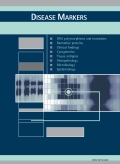Authors: Sethi, Astha | Misra, Anoop | Pandey, Ravindra Mohan | Luthra, Kalpana | Devi, J. Rama | Sharma, Rekha | Khanna, Nidhi | Dwivedi, Manjari | Vikram, Naval Kishore
Article Type:
Research Article
Abstract:
Background: High prevalence of diabetes, obesity, and dyslipidemias in people belonging to poor socio-economic strata in urban slums of northern India has been recorded recently. To assess whether this population has high levels of soluble intercellular adhesion molecule-1 (sICAM-1), a cytokine involved in the pathogenesis of atherosclerosis, we investigated subjects belonging to poor socio-economic strata in urban slums and compared them to healthy control subjects from non-slum urban areas of New Delhi. Design: Cross-sectional study.
…Methods: Subjects from a previously carried out cross-sectional study, Delhi Urban Slum Project (DUSP) were divided into two groups: Group-1 (n=56) included subjects dwelling in slum area, having at least one risk factor (hypertension, hyperglycemia, hypertriglyceridemia and hypercholesterolemia), while group-2 (n=60) consisted of subjects without any risk factor dwelling in the slum area. A third group (n=29) of non-obese subjects without any risk factor living in non-slum urban area was included for comparison. Measurements included; body mass index (BMI), waist-hip ratio (W-HR), four skinfolds, percentage body fat, fasting plasma glucose (FPG), serum lipids, and serum levels of sICAM-1. Results: Though statistically not significant, mean level of sICAM-1 was higher in group-1 (718.5 ± 232.8 ng/ml) as compared to the other groups. Of note, 35% of subjects in group-1 (p<0.05 as compared to other two groups), and 25.3% of all subjects had levels of sICAM-1 in uppermost quartile (>850 ng/ml). Partial correlation coefficients (R) of sICAM-1 levels with various parameters adjusted for age were statistically significant for BMI (R=0.27, p<0.05) in group-1; W-HR (R=0.26, p<0.05) and BMI (R=0.19, p<0.05) for group-2; and FPG (R=0.17, p<0.05) for all the subjects considered together. For females, the levels of sICAM-1 were significantly higher in the following: BMI ≥ 25 kg/m^2 (p= 0.04) and FPG >7 mmol/l (p<0.05). Multiple linear regression analysis suggests that an increment in BMI by one kg/m^2 would correspond to an increase in the levels of sICAM-1 by 8.5 units controlling for the influence of age and W-HR in the pooled data of all subjects. Conclusions: High percentage of subjects had levels of sICAM-1 in the upper quartile in the study, particularly those dwelling in the slum area and having coronary risk factor (s). The levels of sICAM-1 strongly correlated to the anthropometric and metabolic parameters, particularly in females. These observations are of potential importance for the pathogenesis of atherosclerosis in this population, though further studies are needed to predict those prone to the complications of atherosclerosis, based on sICAM-1 levels, as has been observed in other ethnic groups.
Show more
Keywords: soluble intercellular adhesion molecule-1, body mass index, obesity, type 2 diabetes mellitus, hyperlipidemia
Citation: Disease Markers,
vol. 18, no. 3, pp. 111-120, 2002
Price: EUR 27.50





